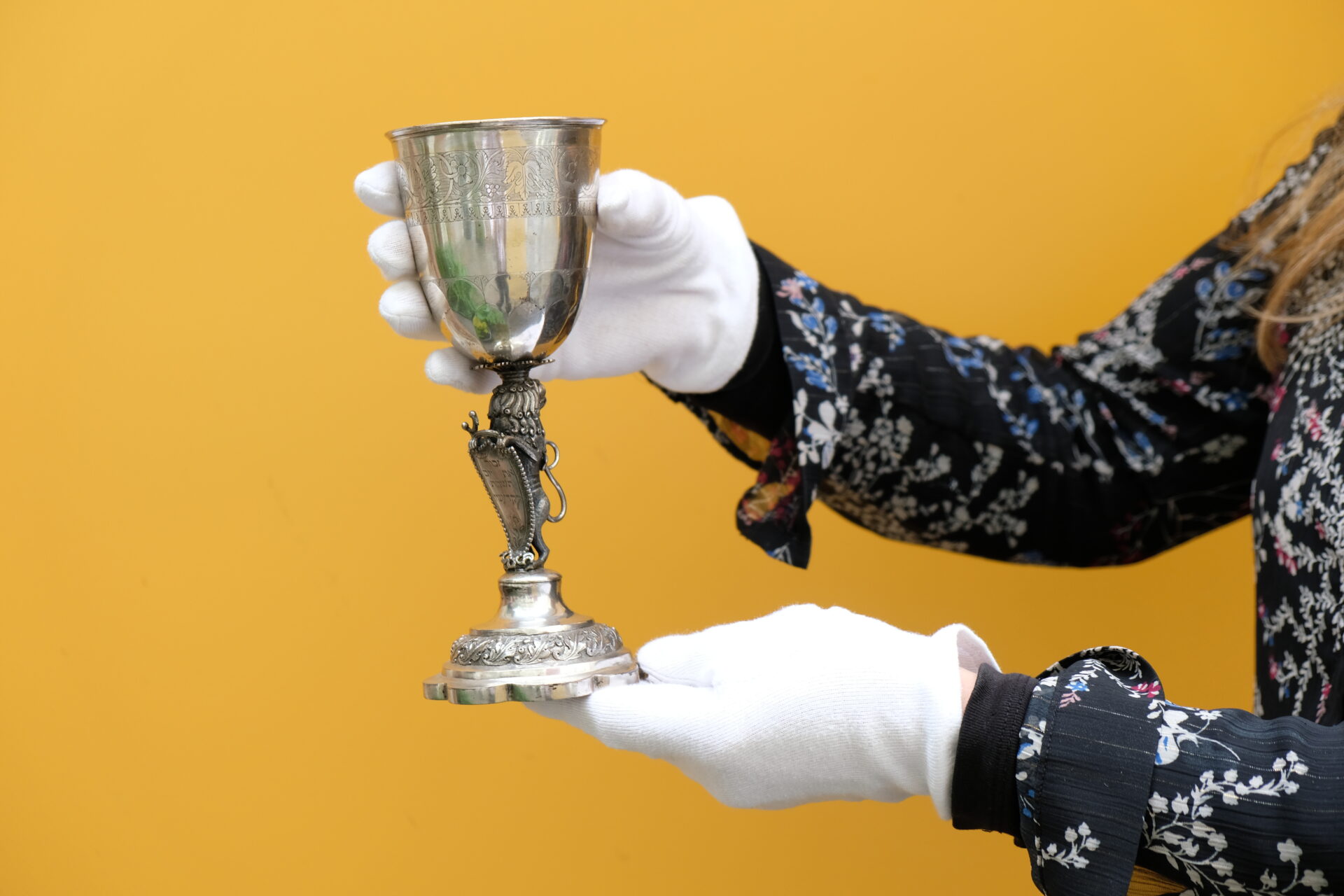Christina Meri with a kiddush cup, JMS 45
Christina Meri, Jewish Museum of Switzerland 2023
Amulettbehälter mit der Inventarnummer 887
Amulettbehälter mit der Inventarnummer 887
Chanukkia mit der Inventarnummer JMS 404
«Forgeries have misled Judaica scholars»
Six Questions to Christina Meri
Forgeries have found their way into many Judaica collections, including our own. In recent years, exchanges between the Jewish museums in Europe and abroad have shed new light on dubious objects. In an interview with museum director Naomi Lubrich, curator Christina Meri points out unusual screws, blurry hallmarks and suspicious details – and explains how a global market traded in Jewish nostalgia.
Naomi Lubrich: Christina, you have identified many fake Judaica in our collection. What are the key types?
Christina Meri: There are forgeries and falsifications, which intended to simulate historical authenticity for interested buyers. In the case of silver objects, they often include forged hallmarks. Typical forgeries are the large number of wedding rings owned by Jewish museums around the world. Until recently, they were sold as antique Jewish-Italian jewelry.
NL: …and falsifications?
CM: Falsifications are authentic historical objects that were later ‹Judaized,› usually by adding Hebrew inscriptions. The best-known falsifications are sugar bowls and toothpick holders, which were sold as besamim boxes (Hebrew: spice boxes). Since Judaica are much rarer than normal silverware, they sold for higher prices, reaping much greater profit. Other types of falsifications are objects consisting of disparate components which were welded together to form a new object. We have a kiddush cup that has a base made of a former candlestick. These composite Judaica often have an authentic silver mark on one of their components.
NL: How did they find their way into the Jewish Museum’s collection?
CM: The Judaica antiquities’ market formed in the 19th century, at a time when private collectors were seeking representative, aesthetic Judaica. Many of the objects on sale were ‹showpieces› for display, as opposed to objects intended for use. At the turn of the 20th century, committees and associations for preserving Jewish cultural artifacts helped erect Jewish museums and departments in local history or folklore museums in many European cities. At the time, Jewish cult objects were studied from an ethnological or art-historical perspective. As a result, the demand for Judaica increased, and with it a growing supply of old – and not so old – Jewish antiquities for the market. Our museum received many Judaica as permanent loans from Swiss museums and as donations from private individuals, especially during its first years after opening in 1966. But over the course of its almost seventy-year history, the museum also purchased some objects which turned out to be forgeries.
NL: How do you examine an object to determine its authenticity?
CM: We look at the quality and workmanship of our objects, and we compare them to other objects from the same time and place. You can often recognize fake silver objects by modern-looking screws, by their wiring or by the soldering. To increase the value of a Judaica object, silversmiths forged hallmarks of reputable craftsmen. So if an object has mismatched city marks and silversmith marks, it cannot be genuine. Also look at the quality: Forgers never attained the quality of the top silversmiths. Once you know about objects put together from disparate parts, examine the styles of each component. You’ll easily recognize if one section has Biedermeier elements and the other looks like it’s Rococo. Look carefully at the engraved inscription for defects in handiwork or spelling errors. And lastly, you can see whether ceremonial objects are useful for their purpose, that is, if they’re functional. We have besamim containers in our collection with openings so narrow that they are impossible to fill with spices, let alone remove the old spices.
NL: Do all the Jewish Museums have the same types of fakes?
CM: Yes, the Jewish museums in Europe have similar forgeries. We believe that a common network of forgers supplied the museums. Looking for our common suppliers is detective work – and very exciting!
NL: How will these objects be written about in thirty years?
CM: For decades, the forgeries have misled Judaica scholars. They found their way into registers and scholarly articles. They shaped our understanding of how religious customs were celebrated. But the forged Judaica of the late 19th century are expressions of their era. They reflect the desire of newly emancipated Jews for a beautiful testimonies of a dignified past. They give us insight into the state of scholarship at a time when the study of Jewish folklore was just emerging. The objects are representative – and conjure up feelings of nostalgia. In thirty years, hopefully, the forgeries will be understood, can be identified, and their context of origin will be reappraised.
NL: Christina, let’s hope it goes faster! Thank you very much for sharing your expertise – along with the following sources:
Vivian B. Mann, The First English Collector of Jewish Wedding Rings and their Dealers, in: IMAGES, Bd. 11, Leiden 2018, 177–185.
Alfred Moldovan, Foolishness, Fakes, and Forgeries in Jewish Art. An Introduction to the Discussion on Judaica Conservation and Collecting Today, in: Clare Moore (Hrsg.), The Visual Dimension. Aspects of Jewish Art, 1. Aufl., Routledge 1993, 105–119.
Bernhard Purin, Judaica in Süddeutschland. Eine Typologie, Kap. 6: Fälschungen, Verfälschungen und Repliken, in: Otto Lohr, Bernhard Purin (Hrsg.), Jüdisches Kulturgut. Erkennen-Bewahren-Vermitteln, Berlin/München 2017, 90–93.
Jay Weinstein, A Collectors’ Guide to Judaica, Kap. 18: Fakes and Forgeries, London 1985.
verfasst am 11.07.2023

Barbara Häne sheds light on a photo album from wartime Switzerland






